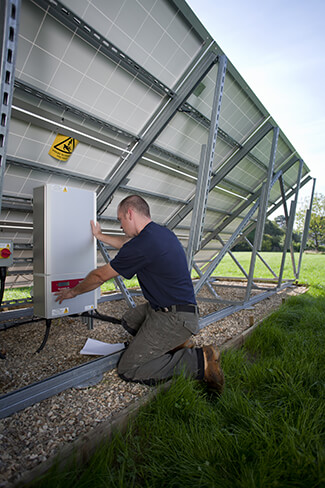5 Solar Installation Best Practices You Need to Know
03
February,
2023
3 MINUTE READ

Installing solar panels can be more complex than you think. There are numerous factors to take into account that go beyond simple functionality. This includes how the system will look, how long it will last, whether maintenance can be completed, how the environment will affect the system, and how you need to label the system to ensure compliance.
Design for Looks

A good solar installation will take looks into account. Customers might be willing to have less than pretty things done to their home, but an ugly installation will lower the house's value, annoy neighbors, and damage the perception of solar technology. Good design should ensure that:
- Each panel is the same color
- Edges of arrays are parallel to the edges of the roof
- Each array is aligned to the same height (typically 3 inches off the roof)
- Conduits on the exterior are concealed when possible
Design to Last
When selecting components, it's important to make sure that they are appropriate for the installation. Components should complement each other. If a critical component has half the expected life as other components, the system might fail before you expect. To ensure the system operates as expected:
- Ensure component warranties are appropriate for the installation
- Understand failure points and eliminate them as possible
- Follow local codes to ensure that the system is built appropriately for its geographic location
Design to be Maintenance Friendly
The solar system should be designed so that there is enough room to perform work safely. From time to time, there will be a need to remove a panel, access conduits, or work with other components. Smart designs will ensure workers can perform work safely.
To help with this, the National Electrical Code, International Building Code, International Residential Code, and other standards provide helpful guidelines for installing solar systems in a safe and efficient manner, which includes designing for maintenance.
Design for the Environment
There are many environmental factors that need to be addressed when installing solar panels. These include elements on the roof as well as wind, seismic activity, and sun levels.
Roof Structures
Residential and commercial buildings often have obstructions (chimneys, parapets, air conditioning units, etc.) that can block some sunlight. Always map out the roof before deciding on a solar system's configuration, maximizing the sunlight panels will receive. Another roof-related factor that needs to be taken into account is structural integrity. Installing an array adds extra weight to the roof, so it's important to ensure that the roof can support the array. When doing this, other factors like water, snow, and debris must be taken into account for the final design.
Wind
Installations need to stand up to the elements. To this end, understanding seasonal wind maximums is essential to ensure that installations are robust. In addition to wind levels, the roof's shape and other architectural elements, like parapets, can affect the wind's force. It's important to understand how the wind will behave, and how to best mount the panels to reduce the chance of damage or vibration from the wind.
Seismic Activity
Depending on where you are installing the solar system, seismic zones and building requirements can vary significantly. In high seismic zones, installations should have guarding around the array to prevent it from falling to the ground during an earthquake. Some states, like California, have very strict specifications, and it's essential for you to contact your local Authority Having Jurisdiction (AHJ) to ensure your installation meets all required codes.
Sun Levels and Power Demand
It's important to understand the electricity demand of a given area when installing solar panels. In many areas, peak energy demand is seen in the afternoons of the summer months, due to air-conditioning use. While south-facing panels in these areas produce more total power over the course of the year, west-facing panels produce more power during those peak demand times. In some cases, this will be more valuable, better matching the customers' needs and reducing strain on the grid.
As with any installation, it's essential to understand the environment and how to maximize the solar energy your customers can use.
Labeling Your System
Before you begin installing a solar system, preferably during the design phase, it's important to understand which labels will be required. To help with this, the National Electrical Code (NEC) has clarified labeling requirements for solar systems in its 2017 revision. Details for solar systems can be found in Article 690 of the NEC. Some labeling requirements can vary depending on the system's configuration. For example, each of the following have special requirements:
- Standalone systems
- Interconnected systems
- Back-fed overcurrent protection devices
- Solidly grounded systems
- Systems with rapid shutdown switches
To help navigate the NEC's latest labeling requirements, Duralabel developed a comprehensive Solar Labeling Guide that will help you understand the labels your installation will need.
RELATED RESOURCES

Hazard Pictograms
What are Hazard Pictograms? Hazard pictograms are graphic symbols used on GHS labels to communicate ...
Read
June 2016 GHS Timetable
With its publication in the Federal Register on March 26, 2012, OSHA's rewritten Hazard Communication ...
Read
Free OSHA GHS Training
OSHA GHS Proposal OSHA mandated changes to its hazard communication standard (HCS), and aligned itself with ...
Read.png)


